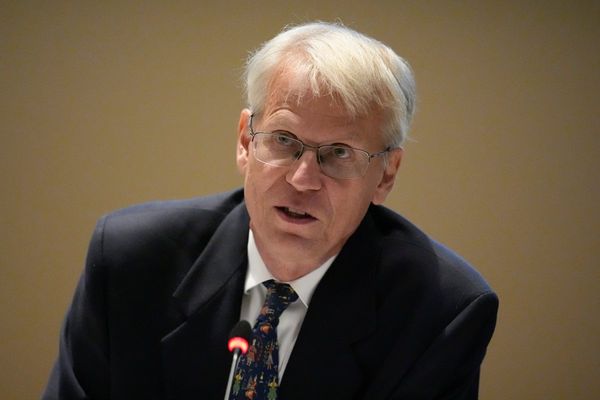
My windscreen exploded when I hit a 16-year-old cyclist with my Toyota Corolla in March, on what was meant to be just a quick trip to the bakery. Glass covered the bag of pastries on my passenger seat as I came to a stop at the end of my street, just 200 metres from my front door.
Having flown over my bonnet, the kid was lying on the dewy Brunswick asphalt in a crumple of shock and school uniform, the balance of our lives suspended in his cries: “My back! My back! My back!”
This past Saturday, three months to the day since that accident, I went to watch someone deliberately crash a car at Hobart’s Dark Mofo festival. The Brazilian performance artist Paula Garcia was about to willingly pilot an Audi TT into a head-on collision with another Audi TT at the Royal Hobart Regatta Grounds.
The work, Crash Body, was the first time Garcia had performed it before an in-person audience. Its first staging in 2020, then titled RAW, was live streamed from a São Paulo gallery when Brazil’s pandemic lockdown came into effect on the day of the performance.
A disciple of the famed Serbian performance artist Marina Abramović, Garcia spent eight years training her body and undertaking stunt driving lessons in preparation for RAW – the culmination of years of physically demanding works testing Garcia’s bodily fragility, strength and resilience. She emerged from the car unscathed in 2020 – but one can’t count on the same outcome twice.
On Saturday, the cold winter night was thick with anticipation when, after a lengthy wait, Garcia and the stunt driver manning the other car strode into the clinical light bleaching Hobart’s docks. They donned helmets, then strapped into roll cages replacing the cars’ stripped interiors. Children in the crowd of approximately 4,000 emitted howls of bloodlust. For one man, the mechanophilia of the paint, chrome and rubber proved irresistible as he collected shots of the red car’s sleek rear with a telephoto lens.
Each car was a gleaming inversion of the other, Garcia’s red and the stunt driver’s black, with a racing stripe running from grill to windshield. The vehicles anthropomorphised as their engines roared to life. The black car circled the red before pursuing it out of sight into the black night, then chased it back again, faster and faster each time.
Although it was initially described as taking two hours, this cat-and-mouse ballet lasted just 20-odd minutes. With tyres squealing, the drivers whipped through pools of standing water, waves catching the glare. A soundtrack of portentous synthesisers escalated, augmented by sounds transmitted from the microphones strapped to the cars’ engines. The cars sped at each other, only to pull up alongside one another in a series of near misses.
Ordinarily, one is unaware of life’s sudden calamities until it’s too late; afterwards, you are left decoding the events leading up as a postscript. Crash Body happens the other way around: the calamity is inevitable – but when it arrives, the impact is no less shocking.
Finally, the cars flashed their lights from either end of the asphalt in silent challenge, then accelerated. As with my own crash, time froze with the first crunch of metal; a cloud of glass hung sparkling in the air, like a chandelier held aloft by invisible forces. A jolt of electricity shot up my spine and out of my mouth in a gasp; I then felt a wave of embarrassment, for having succumbed to the moment’s titillation.
After an anxious wait, Garcia was prised from the wreckage. She emerged gingerly at first, then pumped her fists in the air to cheers. Surprised by the lack of a Hollywood fireball, the bloodthirsty 10-year-olds behind me debated whether the performance had followed the “laws of regular physics”.
Garcia survived her collision but sustained significant bruising to her shoulders from the harness she wore. The young cyclist I hit, who showed remarkable bravery on the day, fractured two vertebrae and displaced another. To speak of luck is insensitive, but the truth is it could have been far worse if I had been travelling at speed or any number of other terrible variables. Two weeks ago, his mum texted to tell me that his new bike had arrived, and that the physio thinks he’ll be able to play tennis again soon.
When Garcia’s twisted metal spectacle concluded, we were left to ponder life’s precarity, to be thankful for the most important things – like when an accident could have been so much worse, or how precious our bodies are – and the miracle of getting to experience any of it at all, when everything could change irrevocably in an instant.
The wreckage of Crash Body is available to see in Dark Park, Hobart, on 12-15 June, as part of Dark Mofo festival. The writer travelled as a guest of the festival.







